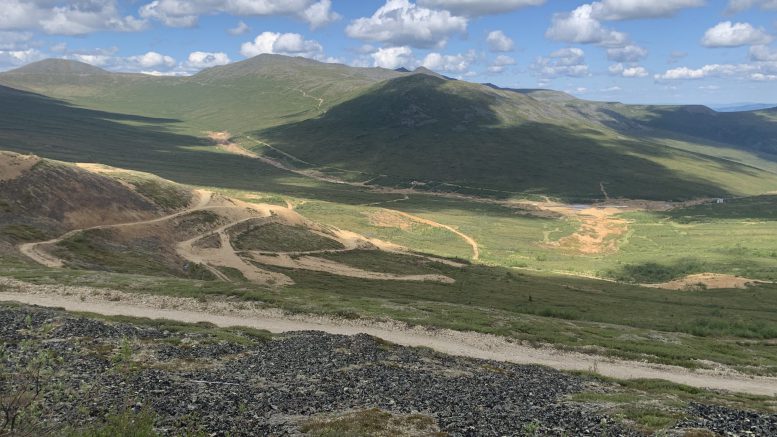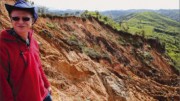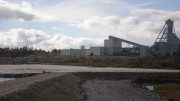Near Carmacks, Yukon — Western Copper and Gold’s (TSX: WRN; NYSE-AM: WRN) Casino project sits at the potential junction of a trans-Canadian green power conduit while promising metals needed for the energy transition.
The company, which calls Casino the world’s fifth-largest copper-gold project controlled by a junior miner, has been buoyed by Rio Tinto (LSE: RIO; ASX: RIO) upping its stake to 9.7% stake last November. There are also tailwinds in the form of governments pushing to connect Yukon to British Columbia’s green power grid and the national grid.
“We’re being dragged. The government of Yukon wants this to happen. The First Nations want it to happen. It comes with that application to the critical mineral infrastructure fund,” Sandeep Singh, who became CEO in February, said in Casino’s hilltop kitchen tent in late June. Singh was referring to the federal government’s $1.5-billion pot to support mining projects, announced last November.
See a video of the site visit
‘Green copper’
“That would reduce our costs from about 18 to 19 cents (per kilowatt hour) to about half that and it would also make the copper coming out ESG-friendly, green copper so it’s a pretty big mover for the project overall.”

Company president Paul West-Sells on a hilltop at the Casino project. Credit: Blair McBride
That possible connection, which is under discussion between B.C. and the Yukon would allow Western to move away from its planned liquefied natural gas (LNG) power source for Casino and also from dirtier diesel generators, widely used for remote projects across the territory. Yukon premier Ranj Pillai asked the federal government earlier in June to provide up to $60 million towards the grid connection, CBC reported. Yukon has already earmarked $1 million towards it.
Casino, located 380 km northwest of Whitehorse, which also continues to enjoy the 4.1% backing of Mitsubishi Materials, is now focused on preparing to submit its environmental studies to the Yukon government this year. It’s about four years away from completing its entire environmental assessment, company president Paul West-Sells said.
Mineral claims at Casino date back to 1917. Western took over the project in 2006 from Ross Beaty’s Lumina Resources, which in 2004 issued an NI 43-101 report for the site.
‘1.2B tonnes’
The copper-gold-molybdenum project holds 1.2 billion proven and probable tonnes grading 0.2% copper, 0.22 gram gold per tonne and 0.02% molybdenum for 5.1 billion lb. copper, 8.5 million oz. gold and 572 million lb. molybdenum, according to a feasibility study released in 2022. The deposit is about 46% copper, 34% gold and 17% molybdenum.
“We are the largest critical minerals project in the country,” Singh said.
While Singh noted the grades might be lower than other deposits, the 0.43:1 strip ratio in the feasibility study, as well as the 1.2 billion reserve tonnes puts Casino ahead of other copper porphyry projects.
Casino can also help respond to the energy transition’s need for 12 million tonnes of copper over the next 10 years if climate change is to be kept under 1.5 degrees, Singh said.
But as excited as company managers are about Casino’s green credentials, there are several risks. And like the tasks of supplying energy transition metals and passing an environmental assessment, they are green challenges in themselves.
Cautionary tailings tales
Among the biggest ones is tailings.
Speaking on a hilltop that overlooks the main camp, West-Sells recalls that about a decade ago tailings “were viewed as weapons of mass destruction.” Communities and regulators were alarmed after B.C.’s Mount Polley and Brazil’s Samarco tailings accidents.
The company started its best available tailings technology study and went through about 40 designs for a tailings dam until it reached agreement on one that uses a limited amount of water. Neighbouring First Nations, the Yukon government and an independent review panel accepted that proposal.
“I talked about nothing but tailings for probably three or four years,” he said. “And now that we’re sort of wrapping everything up again, I don’t talk about it anymore. Which is good. It just says that’s something that’s been dealt with.”
However, it’s possible the company could face similar issues – but this time with its heap leach plans – after the collapse of a heap leach pile at Victoria Gold‘s (TSX: GCX) Eagle mine in June. With a gold heap leach facility also envisioned as part of Casino, The Northern Miner asked Singh if the company fears the accident could damage public acceptance of its project.
He responded it would be irresponsible to comment before more information is known about the incident.
Water and caribou
Closely related to tailings are water systems, a crucial issue considering Casino sits just 16 km south of the Yukon River.
West-Sells explained that Casino is designed to divert all drainage into small local creeks and away from the Yukon River. Any drainage would have to travel about 200 km until it makes contact with the river.
Another risk is caribou populations, an issue West-Sells says he’s aware has caused friction between mineral development and Indigenous groups in the Yukon, such as with BMC Minerals’ Kudz Ze Kayah project to the southeast.
“The herd is healthy in this area. We co-fund a collaring program with the Yukon government,” he said. The program involves collecting baseline information on the population and habitat ecology of the Klaza herd.
Infrastructure momentum
Infrastructure-wise, 80% of the road that would lead from the village of Carmacks to Casino has already been built, and the federal government is expected to chip in 30% of the cost of the last portion, $130 million. Yukon is adding $21 million.
The feasibility study gives Casino a $2.3 billion net present value (at an 8% discount), an after-tax internal rate of return of 18.1% and a three-year payback period. Sustaining capital comes to $751 million for total capital costs of $4.4 billion.
While the study pegs the mine life at 27 years, Singh says he believes that accounts for only a third of the resource. It could last 60 to 80 years as a “generational asset”, he says. And Singh, like West-Sells, emphasizes the project is the right one for the energy transition.
“Part of the reason that the Rios and Mitsubishis of the world like this asset is because it (has) lots of copper, molybdenum (and critical) metals that the world wants,” West-Sells said. “And it’s in Canada and it’s in Yukon and it’s not in a (difficult jurisdiction).”





Be the first to comment on "Site visit: Can Western Copper and Gold rise to its green challenges?"